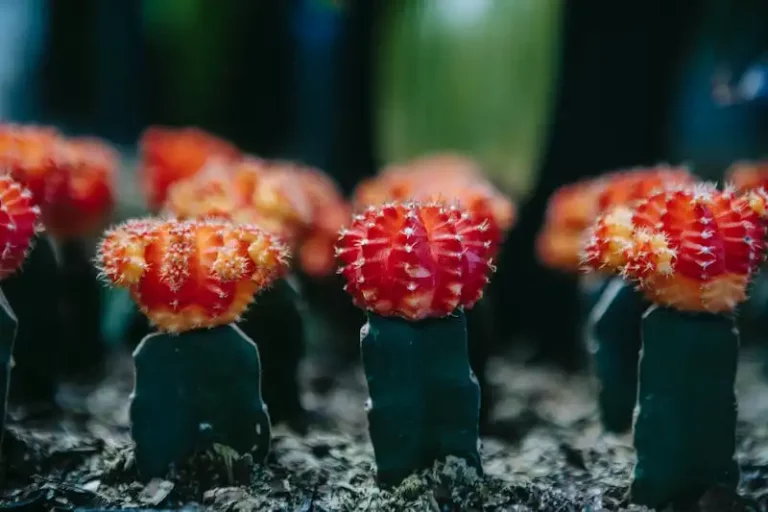If you’re a gardener, you know that Sedum is not only one of the easiest plants to grow, but also one of the most versatile. Whether you’re planting them in the ground or in containers, they thrive in a wide range of conditions and require little care to maintain their beauty.
Sedums come in a variety of colors, from the blue-green foliage of the stonecrop variety to the blue and white flowers of the late-season bloomers. Their thick, succulent leaves not only add texture to your garden, but also act as a natural groundcover, keeping weeds at bay.
One of the best things about Sedums is their ability to stay green year-round. They are great for planting along the edge of a garden or in between stones on a patio, creating a beautiful and low-maintenance effect. Plus, their compact size makes them perfect for adding color to small areas, such as walls or rooftops.
Caring for Sedums is a breeze. They can tolerate both dry and wet conditions, making them ideal for areas with inconsistent weather. As long as you provide them with well-draining soil and plenty of sunlight, they will thrive. Plus, Sedums are easy to propagate, so you can easily expand your collection or give them as gifts to other gardeners.
Proven Winners® offers a wide selection of Sedums, from classic varieties to unique hybrids. Whether you’re looking for a low-growing groundcover or a tall flowering plant, there’s a Sedum for every garden. So why wait? Start growing these amazing plants and enjoy their beauty year-round without all the extra maintenance.
For more information on how to grow and care for Sedums, visit the Proven Winners® website. They have all the tips and tricks you need to keep your Sedums happy and healthy!
How to Grow Sedum
Gardeners choose sedums for their versatility and hardiness. These plants are able to grow in a variety of conditions, making them suitable for almost every garden.
When planting sedums, choose a sunny spot in your garden. Sedums thrive in full sun and will produce the most vibrant blooms and foliage when given plenty of sunlight.
Sedums can be grown in a variety of soil types, but they prefer well-draining soil. If your soil is heavy or clay-like, consider adding some compost or sand to improve drainage. This will help prevent waterlogged roots, which can cause rot.
Plant sedums about 12 to 18 inches apart to allow for proper airflow and prevent overcrowding. This also helps prevent the spread of diseases and pests. However, some varieties, such as creeping sedums, can be planted closer together to create a dense groundcover effect.
Once planted, sedums require little care. Water them regularly in the first season to establish strong roots. After that, sedums are relatively drought-tolerant and can survive on natural rainfall. In fact, overwatering can cause their roots to rot.
Sedums also benefit from an occasional feeding during the growing season. You can use a balanced fertilizer, but be sure to follow the package instructions for the correct application rate.
In late winter, cut back any dead foliage from the previous season to make way for new growth. This will help prevent disease and give your sedums a fresh start. Sedums are generally hardy perennials and can survive the winter without any special protection in most climates.
Sedums are not only loved by gardeners, but also by pollinators. Their flowers attract butterflies and other beneficial insects to your garden. The blooms are usually long-lasting, adding a pop of color to your landscape throughout the growing season.
In addition to being a great choice for traditional garden plantings, sedums are also excellent candidates for rock gardens. Their low-growing, blue-green foliage and late-season blooms are a perfect fit for these types of gardens.
With so many different varieties available, sedums offer endless possibilities for your garden. From upright varieties to groundcovers, there is a sedum to suit every space. Try experimenting with different combinations of sedums to create a unique and eye-catching effect in your garden.
In conclusion, growing sedums is easy and rewarding. They are hardy, low-maintenance plants that can thrive in a variety of conditions. Whether you are an experienced gardener or a beginner, sedums are a great addition to any garden.
When & Where to Plant Sedum
Sedums are a type of succulent that are extremely versatile and easy to grow. They come in a wide range of varieties, from small ground cover sedums to tall sedums that can reach up to three feet in height. Sedums are also known for their thick, fleshy foliage and beautiful blooms. These qualities make sedums a great addition to any garden or landscape.
When it comes to planting sedums, it’s important to consider the weather and climate in your area. Sedums are generally hardy plants that can withstand a variety of conditions, but they do best in locations with full sun and well-draining soil. They are also extremely drought tolerant and can survive in dry conditions.
Sedums can be planted at any time during the growing season, but early spring or late summer are the best times to plant them. If you live in an area with frost, it’s best to wait until after the last frost date to plant your sedums. This will ensure that they are not damaged by freezing temperatures.
When planting sedums, you can choose to plant them individually or in groups. Mass plantings of sedums can create a stunning effect in your garden, especially when planted in combination with other plants. Sedums can also be used as border plants or as a ground cover to fill in areas between other plants. They can be planted in containers or directly in the ground, depending on your preference.
When planting sedums, make sure to space them about 12 to 18 inches apart, depending on the variety. This will give them enough room to spread and grow without overcrowding each other. Sedums can also be divided and replanted to create new plantings. Simply dig up a section of an established sedum and transplant it to a new location.
Sedums are known for their ability to attract pollinators, such as butterflies and bees, with their colorful flowers. By planting sedums in your garden, you can provide a valuable food source for these important insects. In addition to their attractive blooms, sedums also have interesting foliage that can add texture and interest to your landscape.
So, whether you have a sunny rock garden or a rooftop container garden, sedums are the ultimate plants to consider. With their ability to tolerate a wide range of conditions, versatile planting options, and attractive foliage and blooms, sedums are a great choice for any garden or landscape. Read on for more sedum planting tips and FAQ’s in the Ultimate Sedum Growing Guide from Proven Winners®.
How to Grow Sedum Throughout the Season
Sedum plants are versatile and easy to grow, making them a popular choice for planting in any garden. Whether you prefer to grow them in containers or as perennial borders, the Proven Winners variety of Sedum has everything you need to create a stunning display throughout the season.
When planting Sedum, it’s important to choose a location that receives full sun. This will ensure that they receive the amount of light needed to bloom and stay healthy. Sedum plants also prefer well-drained soils, so be sure to provide adequate drainage.
One thing to keep in mind when growing Sedum is that they are late-season bloomers. This means that while they may not flower until late summer or autumn, their long-lasting blooms will make up for the wait. Sedum varieties such as the creeping Sedum clusters provide a unique appeal to any garden.
To care for Sedum plants throughout the season, make sure to keep the soil moist but not soggy. Over-watering can lead to root rot, so it’s important to find the right balance. Adding a layer of mulch can help retain moisture and protect the plants from extreme weather conditions.
Sedum plants are low-maintenance and can be grown in a variety of conditions. They can be used as groundcover to fill in sections of your garden or as a border plant to edge flower beds. When it comes to spacing, Sedum plants should be approximately 12-18 inches apart. This will allow them to spread and grow without overcrowding each other.
In addition to their outstanding flowering abilities, Sedum plants are also known for their ability to attract butterflies and bees. This combination of beauty and functionality makes them a great addition to any landscape.
To keep your Sedum plants flowering throughout the season, it’s important to provide them with the right nutrients. Using a slow-release fertilizer specifically formulated for flowering plants can help provide the necessary food. Be sure to follow the instructions on the package for the best results.
Sedum plants can also be divided and propagated to create more plants. This can be done in early spring or late fall by cutting through the roots and replanting the sections. This is a great way to expand your Sedum collection or share them with friends.
Caring for Sedum plants is relatively easy. They are drought-tolerant and can withstand dry conditions, making them a popular choice for rock gardens. They can also be used as a groundcover to help prevent erosion and keep weeds at bay.
In conclusion, Sedum plants from Proven Winners are a versatile and low-maintenance addition to any garden. They can be grown in a variety of conditions and bring beautiful blooms and long-lasting appeal throughout the season. So, why not try adding some Sedum to your garden this year and see the difference they can make?
Sedum End of Season Care
As the late-season approaches, it’s important to provide extra care for your sedums to ensure their health and longevity. Sedums, also known as stonecrop, are a type of succulent with thick, blue-green foliage. They are perfect for sunny locations and can be used as groundcover or in combination with other plants in the landscape.
When the weather starts to cool down and frost threatens, it’s time to give your sedums some attention. Here are a few tips to help you take care of your sedums at the end of the season:
- Trim the foliage: As the sedums start to die back, trim off any brown or withered foliage. This will help the plant stay neat and tidy throughout the winter.
- Leave the seed heads: Many sedums produce clusters of small, star-shaped flowers in late summer or early autumn. Leaving these seed heads on the plant will provide food for birds and add interest to your garden during the winter months.
- Don’t cut back too early: While it may be tempting to cut back your sedums as soon as they stop flowering, it’s best to wait until spring. The dried flower stems can provide some protection to the crown of the plant during the winter.
- Apply mulch: To protect the sedums from harsh winter conditions, apply a layer of mulch around the base of the plants. This will help keep the soil insulated and prevent frost heaving.
In addition to these end-of-season care tips, it’s important to note that sedums are generally low-maintenance plants. They are drought-tolerant and can thrive in well-drained soil. However, they may need some extra water during extended dry periods.
By following this care guide, your sedums will continue to flourish year after year, providing a beautiful and natural effect in your garden or landscape.




